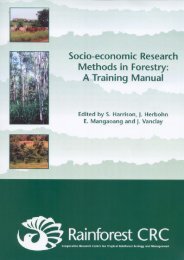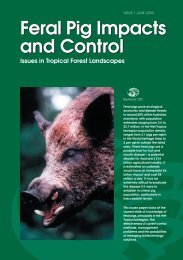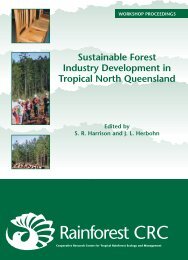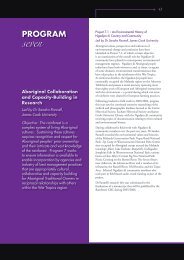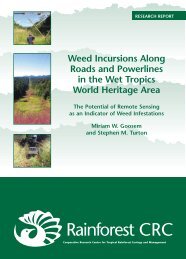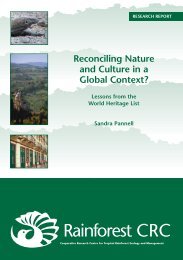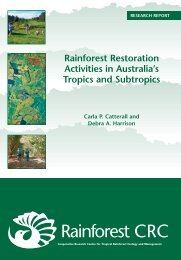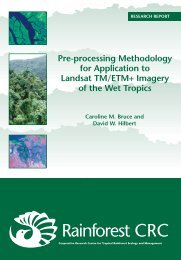Reconciling Nature and Culture in a Global Context? - Rainforest ...
Reconciling Nature and Culture in a Global Context? - Rainforest ...
Reconciling Nature and Culture in a Global Context? - Rainforest ...
You also want an ePaper? Increase the reach of your titles
YUMPU automatically turns print PDFs into web optimized ePapers that Google loves.
<strong>Reconcil<strong>in</strong>g</strong> <strong>Nature</strong> <strong>and</strong> <strong>Culture</strong> <strong>in</strong> a <strong>Global</strong> <strong>Context</strong>?Lessons from the World Heritage Listof Verheijen’s research the village of Modo (aka Komodo village) was comprised of 69houses, the nearby settlement of Nggaro had seven houses <strong>and</strong> a further four houses wereestablished at Liang (also known as ‘Kampung Kechil’ <strong>in</strong> Auffenberg’s study), later tobecome the official site of the National Park’s ranger station <strong>and</strong> tourist facilities. Auffenberg<strong>in</strong>dicates that, <strong>in</strong> the period 1969-1971, there were also settlements at Lawi <strong>and</strong> Sabita(Kampung Lawi <strong>and</strong> Kampung Sabita, aka Bitaq <strong>in</strong> Wana Modo) (1981: 7) 20 . While notmentioned by Verheijen <strong>in</strong> his study of Komodo Isl<strong>and</strong>, two villages, R<strong>in</strong>ca <strong>and</strong> Kerora, arelocated on the isl<strong>and</strong> of R<strong>in</strong>ca, <strong>and</strong> another village, Papagaran, is situated on the isl<strong>and</strong> ofthe same name (PHKA <strong>and</strong> TNC 2000, Vol. 1: 13) 21 . Accord<strong>in</strong>g to Ellis, Kampung R<strong>in</strong>ca was“established after Kampung Komodo, but still well before the gazett<strong>in</strong>g of the [P]ark” (1998:78). Ellis states that <strong>in</strong> 1930, 250 people lived <strong>in</strong> Kampung R<strong>in</strong>ca, while <strong>in</strong> the late 1990sthere were about 700 residents (loc. cit.).Of the eighty-five families compris<strong>in</strong>g the population of the three settlements identified byVerheijen on Komodo, forty were orig<strong>in</strong>ally from villages <strong>in</strong> the Manggarai region of westernFlores, twenty-five were from Bima <strong>and</strong> Sapé <strong>in</strong> eastern Sumbawa, six were from Sumba<strong>and</strong> the rema<strong>in</strong><strong>in</strong>g fourteen families orig<strong>in</strong>ated from other places with<strong>in</strong> eastern Indonesia(Needham 1986: 54-55). Of these eighty-five families, eight ‘family heads’ had immigrated toKomodo Isl<strong>and</strong> s<strong>in</strong>ce the end of the Second World War (loc. cit.). While Verheijen’sdiscussion of ‘immigrant families’ may give the impression that there were no Ata Modopeople liv<strong>in</strong>g <strong>in</strong> the village of Komodo <strong>in</strong> 1977, Needham <strong>in</strong>dicates that some of these‘immigrants’ married local Komodo people or have Ata Modo relatives. In <strong>in</strong>terviews Iconducted <strong>in</strong> October 2005, some of the residents of Kampung Komodo identifiedthemselves as the descendants of the orig<strong>in</strong>al union between an Ata Modo woman <strong>and</strong> thefirst Sumbanese man to arrive on the isl<strong>and</strong>. A 1987 report by the Indonesian anthropologistI Gusti Ngurah Bagus identifies 18.4% of people liv<strong>in</strong>g with<strong>in</strong> Komodo National Park as‘Indigenous’, with Bajo <strong>and</strong> Bugis people respectively compris<strong>in</strong>g 33.3% <strong>and</strong> 27.6% of thetotal population (Bagus 1987: 175). As discussed <strong>in</strong> the next sections, the issue of<strong>in</strong>digeneity lies at the heart of management perceptions of people <strong>and</strong> culture with<strong>in</strong> thePark.Verheijen himself speaks of a ‘Komodo clan’ <strong>and</strong> dist<strong>in</strong>guishes this group from the “found<strong>in</strong>gclans from Sumba”, Wélaq (western Flores), Ambong (Ambon) <strong>and</strong> Kapu (western Flores)(1982: 4). Accord<strong>in</strong>g to Ellis, one of the other found<strong>in</strong>g clans on the isl<strong>and</strong> is comprised ofpeople from Sapé. These people were not granted rights <strong>in</strong> l<strong>and</strong> by the Ata Modo but<strong>in</strong>stead “received the rights to the gebang palm trees, from which a food staple similar tosago is made” (1998: 73-74). As <strong>in</strong>dicated on a detailed map of Komodo appended toVerheijen’s monograph (Map 2), each of these five clans is associated with a circumscribedterritory. The territory of the Komodo clan is the most extensive <strong>and</strong> occupies the westernhalf of the isl<strong>and</strong>, while the l<strong>and</strong>s of the four other clans are located <strong>in</strong> the south-eastern(Sumba clan), north-eastern (Ambong <strong>and</strong> Kapu clans) <strong>and</strong> central eastern (Wélaq clan)sections of the isl<strong>and</strong>. Interest<strong>in</strong>gly, the village of Komodo is located <strong>in</strong> the territory identifiedas that of the Wélaq clan, which claims the smallest territory of all the clan groups on theisl<strong>and</strong>.20 In <strong>in</strong>terviews I conducted <strong>in</strong> October 2005, residents of Kampung Komodo also stated thatpreviously there was also a small settlement <strong>and</strong> gardens at Gunung Ara (<strong>in</strong> the Komodo languageNtodoh Puah) <strong>and</strong> Tanjung Kun<strong>in</strong>g (Ntodoh Dato).21 The <strong>Nature</strong> Conservancy ‘Natural History Guide to Komodo National Park’ states that the village ofKerora was established <strong>in</strong> 1955 by “immigrants from [nearby] Warloka village” <strong>in</strong> western Flores,while Papagaran is said to previously have been a “temporary settlement for fishermen” (Erdmann2004: 13). Prior to 1998, when the borders of the national park were extended, the village ofPapagaran was situated outside of the park (PHKA <strong>and</strong> TNC 2000, Vol. 2: 55).25




